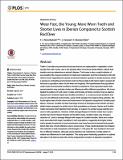Por favor, use este identificador para citar o enlazar a este item:
http://hdl.handle.net/10261/121489COMPARTIR / EXPORTAR:
 SHARE SHARE
 CORE
BASE CORE
BASE
|
|
| Visualizar otros formatos: MARC | Dublin Core | RDF | ORE | MODS | METS | DIDL | DATACITE | |

| Campo DC | Valor | Lengua/Idioma |
|---|---|---|
| dc.contributor.author | Pérez-Barbería, Francisco J. | es_ES |
| dc.contributor.author | Carranza, Juan | es_ES |
| dc.contributor.author | Sánchez-Prieto, C. | es_ES |
| dc.date.issued | 2015 | - |
| dc.identifier.citation | PLoS ONE, 10(8): e0134788 (2015) | es_ES |
| dc.identifier.uri | http://hdl.handle.net/10261/121489 | - |
| dc.description.abstract | Teeth in Cervidae are permanent structures that are not replaceable or repairable; consequently their rate of wear, due to the grinding effect of food and dental attrition, affects their duration and can determine an animal's lifespan. Tooth wear is also a useful indicator of accumulative life energy investment in intake and mastication and their interactions with diet. Little is known regarding how natural and sexual selection operate on dental structures within a species in contrasting environments and how these relate to life history traits to explain differences in population rates of tooth wear and longevity. We hypothesised that populations under harsh environmental conditions should be selected for more hypsodont teeth while sexual selection may maintain similar sex differences within different populations.We investigated the patterns of tooth wear in males and females of Iberian red deer (Cervus elaphus hispanicus) in Southern Spain and Scottish red deer (C. e. scoticus) across Scotland, that occur in very different environments, using 10343 samples from legal hunting activities. We found higher rates of both incisor and molar wear in the Spanish compared to Scottish populations. However, Scottish red deer had larger incisors at emergence than Iberian red deer, whilst molars emerged at a similar size in both populations and sexes. Iberian and Scottish males had earlier tooth depletion than females, in support of a similar sexual selection process in both populations. However, whilst average lifespan for Iberian males was 4 years shorter than that for Iberian females and Scottish males, Scottish males only showed a reduction of 1 year in average lifespan with respect to Scottish females. More worn molars were associated with larger mandibles in both populations, suggesting that higher intake and/or greater investment in food comminution may have favoured increased body growth, before later loss of tooth efficiency due to severe wear. These results illustrate how independent selection in both subspecies, that diverged 11,700 years BP, has resulted in the evolution of different longevity, although sexual selection has maintained a similar pattern of relative sex differences in tooth depletion. This study opens interesting questions on optimal allocation in life history trade-offs and the independent evolution of allopatric populations | es_ES |
| dc.language.iso | eng | es_ES |
| dc.publisher | Public Library of Science | es_ES |
| dc.relation.isversionof | Publisher's version | es_ES |
| dc.rights | openAccess | es_ES |
| dc.title | Wear Fast, Die Young: More Worn Teeth and Shorter Lives in Iberian Compared to Scottish Red Deer | es_ES |
| dc.type | artículo | es_ES |
| dc.identifier.doi | 10.1371/journal.pone.0134788 | - |
| dc.description.peerreviewed | Peer reviewed | es_ES |
| dc.relation.publisherversion | http://dx.doi.org/10.1371/journal.pone.0134788 | es_ES |
| dc.rights.license | http://creativecommons.org/licenses/by/4.0/ | es_ES |
| dc.relation.csic | Sí | es_ES |
| dc.identifier.pmid | 26252380 | - |
| dc.type.coar | http://purl.org/coar/resource_type/c_6501 | es_ES |
| item.openairetype | artículo | - |
| item.grantfulltext | open | - |
| item.cerifentitytype | Publications | - |
| item.openairecristype | http://purl.org/coar/resource_type/c_18cf | - |
| item.fulltext | With Fulltext | - |
| item.languageiso639-1 | en | - |
| Aparece en las colecciones: | (EBD) Artículos | |
Ficheros en este ítem:
| Fichero | Descripción | Tamaño | Formato | |
|---|---|---|---|---|
| journal.pone.0134788.pdf | 4,7 MB | Adobe PDF |  Visualizar/Abrir |
CORE Recommender
PubMed Central
Citations
12
checked on 22-abr-2024
SCOPUSTM
Citations
22
checked on 15-abr-2024
WEB OF SCIENCETM
Citations
21
checked on 27-feb-2024
Page view(s)
280
checked on 23-abr-2024
Download(s)
214
checked on 23-abr-2024

